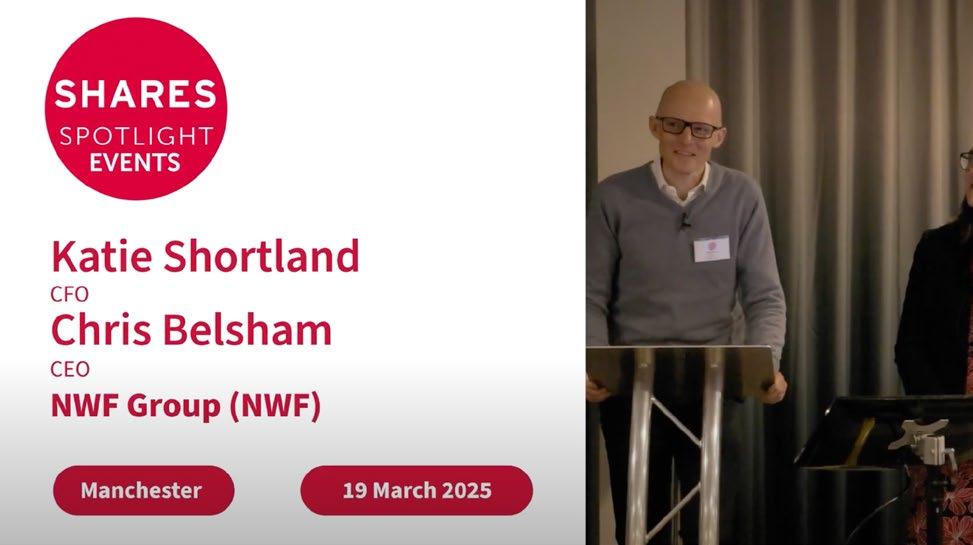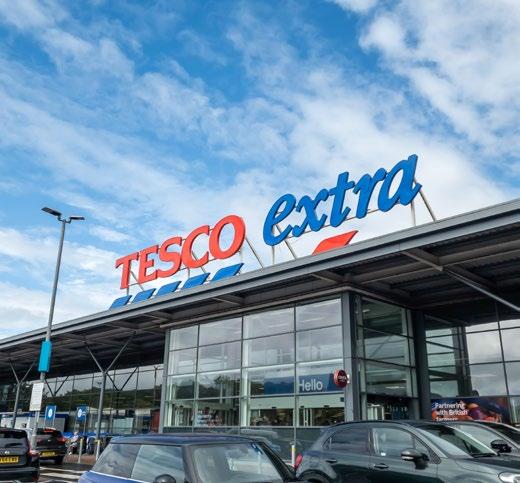WAR

WHAT IT MEANS FOR MARKETS AND WHERE TO INVEST
05 EDITOR’S VIEW
Why selling in a panic has always proved a mistake
07 Markets price in increased odds of recession as tariff uncertainty bites
08 ‘Liberation Day’ sell-off ranks up there with the worst of them
10 What the experts are saying about the tariff-driven selling
11 Currys’ shares gain 60% over the past year
1 1 Travis Perkins shares hit 15-year low after profit warning
12 Sainsbury’s has become a beacon of calm in a turbulent market
13 Investors will scrutinise 2025 earnings guidance from the ‘Big Four’ US banks
1 5 How investors can stay invested at an attractive price with Fidelity Index World
1 7 Why you should buy ASML while there is widespread market weakness UPDATES
19 A 20% profit is on the table at prepared foods maker Bakkavor
20 COVER STORY TRADE WAR
Why you should not overreact and how to dial down risk


has my state pension taken a


Three important things in this week’s magazine
TRADE WAR

Tariff wars: don’t let emotion take over
With markets suffering big falls it’s tempting to feel you should tinker with your investments, but we explain why the best strategy is to ‘keep calm and carry on’.



Why the IPO market has yet to take off
While takeovers and mergers continue to reduce the ‘pool’ of UK companies available to investors, new listings are running well below historic levels as companies wait for markets to settle.
Visit our website for more articles
Did you know that we publish daily news stories on our website as bonus content? These articles do not appear in the magazine so make sure you keep abreast of market activities by visiting our website on a regular basis.
Over the past week we’ve written a variety of news stories online that do not appear in this magazine, including:


How investment trusts use gearing to improve returns
Unlike open-ended funds, investments trusts can use their permanent capital structure to raise debt and leverage their returns –we explain the process and speak to the managers.


Add Definition to Your Portfolio
Defined outcome strategies that increase potential to reduce systematic risk and equity volatility.
Markets price in increased odds of recession as tariff uncertainty bites
The so-called fear index spiked to its highest level since Covid
Aweaker dollar, cheaper oil and lower 10-year treasuries were high up on US treasury secretary Scott Bessent’s agenda when he came into office.
Crashing stock markets was not on the list, but this is exactly what has happened since Trump unveiled his barrage of global tariffs on 2 April, causing the third steepest two-day decline in the S&P 500 index this century.
At times like these it worth looking at the performance of other asset classes for clues as to the wider ramifications. One of the most important in the context of tariffs and trade, are currencies.
One thing which stands out like a sore thumb has been the lack of dollar strength. Ordinarily, as the world’s reserve currency the greenback would be expected to see strength as investors flock to the relative safety of US treasuries.
It hasn’t happened this time around and the dollar has now given back all the gains since the US election which were driven by a perception of socalled ‘US exceptionalism’. Dollar weakness could signal a lack of trust in US assets which would be a worrying development.
It may also reflect actions taken by countries retaliating against Trump’s tariffs in other ways. For example, French president Emmanual Macron has urged EU companies to pause investing in the US, arguing for ‘collective solidarity.’
Oil prices have collapsed with Brent crude dropping from over $80 a barrel in early January to $62 on 7 April, a new four-year low. This reflects increasing fears of economic slowdown brought about by tariff uncertainty and a decision by the OPEC+ producers’ cartel to increase production.
Investment bank Goldman Sachs has lowered its forecast for oil prices and now expects Brent crude to average $62 in 2026, reflecting lower demand amid weaker economic growth.
The bank raised the odds of a US recession to 45% from 35%, after increasing the chances of recession from 20% only a week earlier.
Expectations for lower growth coupled with a

flight to safety pushed bonds yields down (prices up) with two-year treasury yields sinking to a low of 3.5% on Friday (4 April) from 3.9% a week earlier.
Intriguingly, 10-year treasury yields rose back above 4% on Friday, after touching 3.8%, reflecting fears over the inflationary impact of tariffs. Increased odds of recession can also be seen in widening credit spreads with the US high yield spread spiking to 4.5%, its highest in 18 months. Companies with weaker balance sheets have a higher risk of default, particularly during economic downturns. [MG]
‘Liberation Day’ sell-off ranks up there with the worst of them
Achieving a coordinated response to the crisis might be tricky
When Donald Trump became president for the second time, many observers assumed he would use the stock market as a barometer of how well or how badly his policies were affecting US confidence as he did during his first term.
However, this notion of markets forming a ‘guard rail’ has been well and truly dispelled by the destruction of trillions of dollars of household wealth as stocks and other assets have lurched lower, culminating this month in one of the worst three-day falls in history as the ‘Liberation Day’ tariffs were announced.
Between the close on Tuesday 2 April and the close on Monday 7 April, the MSCI World index lost 11.6% of its value while the S&P 500 dropped 10.7% and the Nasdaq 100 dropped 11.1% leaving

all three indices in negative territory on a one-year basis.
Having witnessed Black Monday and a number of other collapses first-hand (Japan in 1989, Russia in 1994, Asia in 1997, 9/11 in 2001 to name a few), there is one key difference which investors need to take on board.
In the past, major sell-offs have usually elicited a coordinated global response with
Which were the best- and worst-performing FTSE 350 stocks?
Return measured from close Weds 2 April 2025 to close Mon 7 April 2025
Shares magazine

Mark Hawtin, head of Liontrust global equities team: ‘We can understand why markets have reacted as they have because, if fully enacted, the tariffs have far-reaching impacts and many unintended consequences. Trump is singlehandedly meting out huge cost problems on the iconic brands created in the US.’
Ben Conway, chief investment officer and head of fund management at Hawksmoor Investment Management: ‘Tariffs cause prices to increase, and many fear this may increase inflation (and more specifically, inflationary expectations). At the same time, many fear they will dampen economic activity across the globe, but the fears regarding the US economy are particularly acute given its current weak economic position (being close to a recession).’
Ben Leyland and Rob Lancastle of the JOHCM Global Opportunities fund said: ‘Whether all the tariffs will be implemented – most of those announced year to date have not been – is not clear, but they are likely to lead to a fragmenting geopolitical environment in which regional selfsufficiency needs to be re-established and rebuilt, likely supported by fiscal stimulus. Our portfolios have been constructed with this in mind since 2022 and we see little reason to change this view currently.’
Charles Jillings, fund manager at Utilico
Emerging Markets: ‘Vietnam notably stands out from the rest with a very high 46% tariff applied as Vietnam has a significant imbalance in US export exposure, exporting $97 billion worth of goods in 2023 to the US without any meaningful counterbalance on the import side of the equation.’
Anita Wright chartered financial planner at Bolton James said: ‘All it took was one man and a round of tariffs to shake the system. Had it not been tariffs, something else would have eventually triggered the collapse. But the reckoning is now upon us. The once-favoured mantra of buy the dip has given way to don’t try to catch a falling knife.’
Alex Tedder, chief investment officer, equities at Schroders: ‘Perhaps most surprising has been the action taken against many of the south east Asian countries where many US and international sportswear and apparel companies had re-routed supply chains following Trump 1.0’s tariff action against China.’
Berenberg analysts said: ‘If Donald Trump’s trade war and the equity market sell-off trigger a global recession, the UK would of course struggle. However, the UK is relatively well placed to weather the tariff shock. The additional 10% rate it faces is at the bottom end of the range imposed by the US. Healthy consumer finances, lower energy prices and a fall in interest-rate expectations will also help.’
Currys’ shares gain 60% over the past year
The electrical retailer has raised profit guidance twice in 2025
Shares in Currys (CURY) have gained 60% over the past year as the electrical retailer experiences meaningful recovery in its Nordic business and solid sales from its UK operation.
On 3 April the company raised its profit guidance for the second time in 2025 due to ‘robust’ trading in the period since 4 January.
Investors also welcomed news the FTSE 250 constituent expects to close the year in a ‘strong’ net cash position.
comments: ‘The primary driver of Currys’ profit growth and earnings upgrades had been self-help through sustainable gross margin and cost-savings initiatives, from which there is more to come.
‘What has now changed is that, for the first time in four years, both the group’s UK & Ireland and Nordics divisions are delivering positive like-for-like sales growth.

‘We think this has been driven by some uptick in consumer confidence, yet there is also an enduring, post-Covid-19 technology replacement cycle that is now kicking-in.’
Investment bank Berenberg
In March 2024, Currys
Chart: Shares magazine • Source: LSEG
successfully brushed off interest from US private equity firm Elliot Advisors rejecting an initial £700 million offer (62p) and subsequent £757 million bid (67p) on valuation grounds saying these ‘significantly undervalued’ the business. [SG]
Travis Perkins shares hit 15-year low after profit warning
Builders’ merchant blames continued decline in market volumes and weakness in its merchanting segment
The outlook is far from rosy for Travis Perkins (TPK) with shares hitting a 15-year low (1 April) as the builders’ merchant warned profit this year would miss forecasts due to ‘challenging conditions’.
The Northampton-based firm blamed deflation as it slipped to a pre-tax loss of £38.4 million for 2024

from a profit of £121 million the previous year. The company’s plan to revive its fortunes has been knocked off course after former Taylor Wimpey (TW.) boss Pete Redfern had to step down as CEO due to ill health after just a few months in the role. Chair Geoff Drabble, formerly of Ashtead (AHT), who, like Redfern, was brought in last year, now faces the task of appointing a successor.
On the positive side, the firm reported good progress in its Toolstation business which increased operating profit by almost 50% due to strong sales, improved gross margins and supply chain and overhead efficiencies.
Harry Goad, analyst at Berenberg notes the ‘potential scope for market
recovery and self-help initiatives’.
He adds: ‘Our updated EBITA (earnings before interest taxation amortisation) reflect 7% growth preproperty and 2% growth including property profit in full year 2025 and so we reflect a slightly more optimistic outlook than company guidance.’ [SG]
Investors will scrutinise 2025 earnings guidance from the ‘Big Four’ US banks
JPMorgan chief executive
Although we previewed this Friday’s upcoming first-quarter results (11 April) from the world’s largest bank JPMorgan (JPM:NYSE) in last week’s magazine, these days an awful lot can change in markets in the course of a week.
Previously, chief executive Jamie Dimon had been upbeat about the outlook for the bank, claiming businesses were more optimistic about the economy thanks to president Trump’s ‘pro-growth agenda and improved collaboration between government and business’.
This week, in his annual letter to shareholders, Mr Dimon – who is a widely-respected figure in the US establishment, having led JPMorgan for more than 18 years – warned tariffs would ‘likely increase inflation and are causing many to consider a greater probability of a recession’.
‘The quicker this issue is resolved the better, because some of the
negative effects increase cumulatively over time and would be hard to reverse,’ said the chief executive, adding his ‘most serious concern’ was how tariffs would affect America’s longterm economic alliances.
The next few days sees results not just from JPMorgan but the rest of the ‘Big Four’, Bank of America (BAC:NYSE), Citigroup (C:NYSE) and Wells Fargo (WFC:NYSE). Bank of America is the secondlargest lender in the US and the second-biggest bank in the world by market cap after JPMorgan, with which it competes in savings and loans serving around 10% of all American bank deposits.
When it published its fourthquarter results in January, which like JPMorgan were driven higher mainly by global markets activity, the bank’s chief executive Brian Moynihan said it was well set up for 2025 and he looked forward to ‘driving the company forward against the backdrop of a solid economic environment’.
US UPDATES OVER THE NEXT 7 DAYS
QUARTERLY RESULTS
3-day return from close Weds 2 April to close Mon 7 April 2025
Source:
Meanwhile, Wells Fargo is the second-largest retail mortgage lender in the US, originating one in every four home loans and servicing some $1.8 trillion in mortgages, and chief executive Charlie Scharf has pinned his hopes for 2025 on growing the credit card and retail banking business. [IC]
11 April: Bank of New York Mellon, Blackrock, JPMorgan, Morgan Stanley, Wells Fargo 14 April: Goldman Sachs, M&T Bank 15 April: Bank of America, Citigroup, J&J, PNC Financial 16 April: Abbott Labs, Crown Castle, CSX, Elevance Health, Equifax, Kinder Morgan, Prologis, Travelers, US Bancorp
17 April: Blackstone, Freeport-McMoran, Marsh McLennan, Pentair, Pool, State Street, United Health

MSCI World
July 1997 – Asian financial crisis roils markets
March 2000 – Collapse of technology bubble
September 2008 – Great Financial Crisis destroys wealth
Chart: Shares magazine • Source: LSEG
market countries. By tracking this index, Fidelity Index World provides access to a who’s who of market leading names including iPhone seller Apple (AAPL:NASDAQ), Jensen Huang-steered chips outfit Nvidia (NVDA:NASDAQ) and software firm Microsoft (MSFT:NASDAQ).
Buying shares in this £10.62 billion of assets fund also provides exposure to the likes of online retail-to-cloud giant Amazon (AMZN:NASDAQ), Mark Zuckerberg-led Facebook-parent Meta Platforms (META:NASDAQ) and search and cloud business Alphabet (GOOG:NASDAQ), not to mention Warren Buffett’s Berkshire Hathaway (BRK.B.NYSE), one of the largest companies in the US employing several hundred thousand people through its railroad, manufacturing, retailing, energy, confectionery and insurance businesses and which also boasts a gargantuan investment portfolio.
As at 28 February 2025, Fidelity Index World had nearly three quarters (72.25%) of its assets in the US, so its fortunes are largely tied to the success of the world’s biggest stock market. But because of how the index works, if stocks in the US market started to become less popular, weightings would shift, and holdings from other markets would move
February 2020 – Onset of Covid-19 triggers lockdowns
in to make up a larger percentage of the index and therefore the fund, whose next biggest allocations are to Europe, Japan and the UK.
Shares also observes that Fidelity Index World’s underlying portfolio offers a reassuring balance between cyclical, economically sensitive and defensive sectors, at 32.1%, 48.1% and 19.8% of assets respectively.
Prospective investors are buying into a fund with projected earnings growth of 10.45% and a near-2% dividend yield. Fidelity Index World has generated a cumulative five year return of 95.1%, comfortably ahead of the 69.6% from the Investment Association’s Global sector. Morningstar data shows Fidelity Index World has delivered three, five and 10-year annualised total returns of 7.39%, 14.81% and 10.97%, nicely ahead of the 5.51%, 11.79% and 8.39% from the research firm’s Global Large-Cap Blend Equity category. While Fidelity Index World provides exposure to a plethora of companies around the globe, it is important to note its focus on developed markets. Therefore, investors who want to broaden their horizons and also include emerging markets should look at funds that track the widely followed MSCI ACWI index instead. [JC]
year in the future, an element of crystal ball gazing that leads to miscalculations.
WHY INVEST NOW?
Which brings us neatly on to the why now part of the debate. For simplicity’s sake, we’ve boiled it down to three core issues: tariffs and recession, US chip onshoring, and valuation.
President Trump wants more stuff made in America, and particularly advanced technology that is powering the AI revolution to retain some sort of hegemony and control. Chips are a perfect example. Its why top levels negotiations have already taken place with TSMC, the world’s biggest chip manufacturer, and others, and why Trump is so keen to find a ‘friendly’ partner for struggling Intel.
The president’s tariffs as they stand will harm the industry in the short-term, and industry which is sensitive to economic prosperity, or lack thereof, so if the US does plunge into recession, expect more volatility. Yet the flip side is the huge investment in new US-based capacity already in the pipeline, and likely to accelerate further as time ticks by, to significantly increase fabrication facilities Stateside.
These foundries take years to build from scratch, up to six or seven, so while the short-term outlook for the industry will remain volatile, the ground is being seeded for future growth like never before. This increased US onshoring should see demand for ASML’s most advanced EUV machines steadily increase over the coming years to meet this new fabs capacity. Add in foundry capacity expansion across ASML’s home EU markets, and that it is still allowed to sell older EUV machines to China, you start to get a sense of how well placed the Dutch firm is to prosper on a medium-to-longer run view.
TWO DECADES DEEP DISCOUNT
EPS = earnings per share
Chart: Shares magazine • Source: LSEG
this year and next (to end December). True, those estimates may face a haircut over the coming months, but even if we assume more conservative growth of, say 15% out to fiscal 2027, it implies a three-year average PE of 22.5.

Which brings us on to valuation. ASML shares have tanked following Trump’s ‘Liberation Day’ tariffs bombshell, seeing a double-digit decline in the past two weeks. They are down from around €700 at the start of 2025 and have fallen from nearly €1,000 over the past year. Yet forecasts have remained robust, with Stockopedia’s consensus implying rough 25% and 21% earnings growth
To put that into perspective, our own calculations show trend compounded earnings growth has run at around 25% over the past two decades.
So, while the share price has been lower during the past five years, the valuation has not.
In fact, according to data compiled by Shares, the stock is trading at a generationally cheap valuation, as the chart shows, and way down on its trend, which implies huge scope for mean regression and a far higher share price down the line, as you might expect for a company that churns out returns on capital of 25% to 35% and returns on equity over 30% respectively, and whose operating margins consistently run at 30%-plus.
Buying shares in any company at any time takes a leap of faith, but pulling the trigger in a panicked market is certainly a bold call, we absolutely accept this. But as we said at the start, history tells us to buy when there is blood on the streets, and buying ASML’s sustainably high-quality stock, we believe, will be a very profitable decision in time. [SF] ASML
A 20% profit is on the table at prepared foods maker Bakkavor
As we suspected, Greencore has sweetened its offer for the food business and so investors have a decision to make
We urged readers to buy chilled prepared-food maker Bakkavor (BAKK) at 150.5p on 13 March 2025 for its cash generation, defensive attributes and positive trading momentum. Shares spotted scope for a further re-rating of the stock given the private label pizza-to-hummus maker continues to rebuild its margins whilst paring debt levels.
WHAT HAS HAPPENED SINCE WE SAID TO BUY?
Bakkavor’s shares surged on news (14 March) the ready meals-to-dessert maker had rejected two takeover offers from rival Greencore (GNC), with the latest 189p per share proposal rebuffed on 10 March on the grounds it ‘significantly undervalued’ Bakkavor and its future prospects.
In our update on 27 March, we urged readers to keep buying Bakkavor on the basis Greencore could be preparing a much-improved offer; we also flagged Bakkavor’s tasty upside potential as a standalone entity mind you. Our hunch proved

Shares magazine • Source: LSEG
correct, as the two food producers subsequently announced (2 April) an agreement ‘in principle’ on the terms of a cash and shares offer valuing Bakkavor at 200p per share or £1.2 billion.
WHAT SHOULD INVESTORS DO NOW?
Some investors will be minded to wait for a firm offer and retain exposure to the combined group’s paper, since the planned merger would create a leading UK convenience food business with meaty combined revenues of roughly £4 billion, strengthened commercial ties and the potential to deliver tasty synergies.
But remember, transformational acquisitions can destroy value, and given the increasingly volatile and uncertain market backdrop arising from Donald Trump’s global tariff war, there is a risk that Greencore walks away from a deal that still needs to pass regulatory clearances. As such, more riskaverse readers might elect to sell their shares in the market now and lock in a respectable 20.7% profit on that original entry price. All in all, a nice problem to have. [JC]
HOW INVESTING REGULARLY CAN HELP YOU NAVIGATE VOLATILITY

Regular investment ensures you remain invested in the market regardless of its direction and helps avoid emotional investment decisions.
When markets are falling, it is easy to let fear or panic set in, making you hesitant to invest in shares. This might protect you from short-term losses but could also cause you to miss out on returns when stocks rebound. By investing monthly, you’ll be better positioned for recovery.
During volatile periods, investing regularly could benefit you through ‘pound cost averaging’. This effect smooths out the ups and downs in the price of a fund or share over time, as you end up buying more shares when prices are lower.
The hypothetical example shown in the chart shows how this might work. If you invested £1,200 as a lump sum in an exchange-traded fund tracking a global index at a price of 500p
you would have 240 shares. If those 240 shares ended the 12-month period at 200p your investment would be worth £480. If instead you invested the same £12,000 at monthly intervals over the course of the year you would end the year with 472 shares worth £944. Nearly twice as much. The two options obviously aren’t mutually exclusive, you can also invest lump sums alongside regular investments as part of a balanced strategy.
Table: Shares magazine Source: Sharescope
7
Feb 2022 to 10 Oct 2022
Consumer Services = Auto Trader, Baltic Classifieds, Deliveroo, Mony, Trustpilot, XPS Pensions. Personal Care = Reckitt, Unilever, Sainsbury, Tesco, Ocado, Greggs.
Table: Shares magazine Source: Sharescope
Consumer Services = Auto Trader, Baltic Classifieds, Deliveroo, Mony, Trustpilot, XPS Pensions. Personal Care = Reckitt, Unilever, Sainsbury, Tesco, Ocado, Greggs.
Table: Shares magazine Source: Sharescope
CAPITAL PRESERVATION FUNDS
Another way to dial down risk and add more defensiveness while remaining invested is to consider capital preservation funds. The general principle behind these funds is that they aim to protect investors capital while increasing its value over time.
As Capital Gearing’s (CGT) Peter Spiller puts it: ‘The trust’s primary objective is not to lose money.’
Looking at the historical track record of capital preservation funds such as Capital Gearing, Ruffer Investment Company (RICA), Personal Assets Trust (PNL) and Latitude Horizon (BG1TMR8), shows they have successfully protected investor’s capital during the biggest bear markets.
Troy Asset Management, which manages Personal Assets says it aims to ‘protect investors’ capital and increase its value over time.’
The equity portion of their portfolio is focused on investing in high-quality businesses which can compound earnings sustainably over time. Holdings include Unilever (ULVR), Nestle (NESN:SWX) and credit card company Visa (V:NYSE).
In contrast, Capital Gearing invests its equity portion almost exclusively in investment trusts trading at a discount to NAV (net asset value).
Latitude Horizon looks to invest in companies which can grow earnings per share sustainably
faster than the market average, trading at a discount to the market.
Ruffer takes a contrarian approach to investing and attempts to minimise risk by avoiding the points of material capital loss in financial markets.
The trust offers investors access to some strategies not widely available to retail investors such as derivative protection and non-traditional assets like commodities and the Japanese yen. [MG]
NEW YEAR, NEW ISA ALLOWANCE
With the start of a new financial year on 6th April comes a fresh £20,000 ISA allowance, offering a tax-efficient way to grow your investments.
While some investors wait until the last minute to use their allowance, starting early in the tax year could give your money more time to benefit from compound growth.
One of the easiest ways to build a strong, diversified foundation for your ISA portfolio from day one is through an investment trust with a proven track record - and few have a history as rich as F&C Investment Trust.
selective investments into private equity,” says Paul Niven, Fund Manager of F&C Investment Trust.
in the market, which has historically been one of the biggest factors in long-term investment success.
We focus on global growth assets and invest predominantly into listed equity, but we also take full advantage of the investment trust structure to make selective investments into private equity”
Since 1868, F&C has helped investors grow their wealth by investing in a carefully curated selection of global companies and private equity opportunities. Its measured, long-term approach aims to ensure that investors stay positioned for both stability and growth, even through changing market conditions.
“We focus on global growth assets and invest predominantly into listed equity, but we also take full advantage of the investment trust structure to make
This well-balanced approach makes F&C an attractive option for investors who are able to make the most of their new ISA allowance at the beginning of the financial year. The earlier you invest, the more time your capital has the potential to grow - allowing you to benefit from reinvested dividends, market gains, and compounding over time.
And for those focused on dividend income, F&C stands out, having delivered 53 years of consecutive dividend growth*. While no investment is risk-free, this level of consistency can be reassuring for investors looking to build wealth steadily.
By using your new ISA allowance early, you’re giving your investments more time
Learn more about F&C Investment Trust at fandc.com

*There is no guarantee that dividends will continue to grow.
Capital at risk. Past performance is not a guarantee of future returns. Eligibility to invest in an ISA and tax treatment depends on personal circumstances and tax rules may change in the future.
This advertisement approved for distribution 08/04/25 by Columbia Threadneedle Management Ltd.
It is worth mentioning that some trusts use derivatives to get exposure to certain markets while others invest in short positions, which are bets that share prices will fall.
This can mean the reported gearing overstates the actual level of market exposure. For example, BlackRock Frontiers (BRFI) reports gross market exposure as 123% (23% gearing) while the net exposure, including short bets is 114% or 14% gearing.
One type of funding which has gone out of favour in recent years is the use of ZDPs (zero dividend preference shares).They were issued by split capital trusts, which issue capital and income shares separately.
Split-capital trusts were embroiled in a big misselling scandal in the early 2000s when they became over-leveraged and suffered huge losses during the market downturn. Many split-caps invested in each other which made the damage even worse. However, some trusts still use these vehicles.
WHICH TRUSTS HAVE INCREASED GEARING?
Chelverton UK Dividend Trust (SDV) is a splitcapital trust which invests in mid-cap and smaller companies to provide income and capital growth. The trust is managed by Chelverton Asset Management which was formed by David Horner in 1998.

HOW DO ZDPS WORK?
ZDPs have a predetermined value which is paid to shareholders on a specific future date. These instruments can be traded on the stock exchange, which means they can be bought or sold at any time, subject to available liquidity.
ZDPs publish a ‘promised yield’ based on an investor holding on to maturity and the trust not going bust. They are relatively predictable and secure as they rank higher than ordinary shares in the event of a wind-up.
Zeros are helpful from a tax planning perspective because the return is taxed as a capital gain rather than income.
The top rate of capital gains tax is 28% (32% from April 2025) compared to top rates of income tax of 40% and 45%.
Data at 13 March 2025

AIC data shows gearing has increased to 60% from a five-year average of 49%. Horner is a big fan of ZDPs and believes they provide good flexibility compared with bank debt.
The trust deploys gearing to boost income and capital growth and has done so throughout the life of the trust.
The increase in gearing in this case reflects the movements in the value of the portfolio relative to the fixed amount of debt.
That said, Horner is positive on the prospects for companies in the portfolio which he believes are undervalued. The trailing dividend yield on the trust is 9.4% and the annual ongoing charge is 2.73%.
The company is in the process of raising new ZDPs to replace the existing facility which matures on 30 April.
EXPLOITING ATTRACTIVE OPPORTUNITIES
Gearing at Fidelity Asian Values (FAS) has moved up notably to 18% compared with a five-year average of 7%.
‘The level of gearing has increased in the last few years largely because we have been able to find more investment opportunities in China, a market which has been out of favour with investors,’ explains portfolio manager Nitin Bajaj.
‘We have always maintained that the level of gearing in the company remains a function of the number of investment ideas we find.’
Similar reasons were put forward by Baillie Gifford Japan (BGFD) when the company reported half year results on 28 March.
The managers wrote: ‘Given the highly attractive investment opportunities available and a low funding cost we have maintained net gearing at the significant level of 20%.’
Fund managers Ailsa Craig and Marek Poszepczynski at International Biotechnology (IBT) point out that investment trusts can take advantage of the ups and downs in the stock market to redeploy gearing and purchase quality stocks at appealing valuations.
‘As investment managers, we can adeptly adjust our gearing positions in response to shifting market conditions and sentiment. For instance, in our fund’s interim report dated February 2021, we reported a gearing level of just 2.3%, implying a very defensive stance regarding the market outlook.
‘Fast forward to the end of February 2025, and our gearing has increased to 11.5%. This significant rise reflects our heightened optimism about the fundamental sector outlook.’
It is a similar story at BlackRock Frontiers which, as the name suggests, focuses on frontier markets, effectively the rung below emerging markets.
Sudaif Niaz, co-manager of BlackRock Frontiers told Shares: ‘The net gearing of the trust has increased from 3.3% in February 2020 to 17.1% at end February 2025, which is around the same level of gearing that we employed one year ago.
‘The rise reflects our optimistic outlook on frontiers and smaller emerging markets, and the numerous bottom-up opportunities that we believe exists in these markets.
‘By increasing our gearing, we are strategically positioning the trust to capitalise on these opportunities, where the ultimate goal is to enhance returns for our clients,’ explained Niaz.
The ability of investment trusts to borrow money, done wisely and judiciously can enhance longterm returns for shareholders but investors should be aware of the risks associated with gearing, in particular their capacity to exacerbate losses.

Martin Gamble Education Editor

Fidelity China Special Situations PLC
An AJ Bell Select List Investment Trust
If you want to take full advantage of the incredible growth of China’s middle classes and a seismic shift towards domestic consumption, you need real on-the-ground expertise.
Fidelity China Special Situations PLC, the UK’s largest China investment trust, looks to capitalise on an extensive, locally based analyst team to make site visits and attend company meetings. This helps us find the opportunities that make the most of the immense shifts in local consumer demand.
China’s growth story
Since its launch in 2010, the trust has offered direct exposure to China’s growth story; from tech giants right the way through to entrepreneurial medium and small-sized companies, and even new businesses which are yet to launch on the stock market. Portfolio manager Dale Nicholls looks to identify and invest in companies that are best placed to capitalise on China’s incredible transformation.
Past performance
Investing in China’s most compelling growth drivers Dale believes a vast and still expanding middle class is increasingly driving stock market returns in China.
“China is well established now as a major driver of growth and investment performance, not just in Asia, but in the wider world. The sheer size of China’s economy, its continued growth and ever-increasing global importance, should see investors increase their exposure to China as part of a balanced investment portfolio.”

Past performance is not a reliable indicator of future returns.
Past performance is not a reliable indicator of future returns
Source: Morningstar as at 28.02.2025, bid-bid, net income reinvested. ©2025 Morningstar Inc. All rights reserved. The FTSE All Share Index is a comparative index of the investment trust
Source: Morningstar as at 28.02.2025, bid-bid, net income reinvested. ©2025 Morningstar Inc. All rights reserved. The MSCI China Index is a comparative index of the investment trust.
Important information
The value of investments can go down as well as up and you may not get back the amount you invested. Overseas investments are subject to currency fluctuations. Investments in emerging markets can be more volatile than other more developed markets. The trust invests more heavily than others in smaller companies, which can carry a higher risk because their share prices may be more volatile than those of larger companies. The shares in the investment trust are listed on the London Stock Exchange and their price is affected by supply and demand. The Trust can use financial derivative instruments for investment purposes, which may expose it to a higher degree of risk and can cause investments to experience larger than average price fluctuations. The investment trust can gain additional exposure to the market, known as gearing, potentially increasing volatility. This information is not a personal recommendation for any particular investment. If you are unsure about the suitability of an investment you should speak to an authorised financial adviser.
The latest annual reports, key information documents (KID) and factsheets can be obtained from our website at www.fidelity.co.uk/its or by calling 0800 41 41 10. The full prospectus may also be obtained from Fidelity. The Alternative Investment Fund Manager (AIFM) of Fidelity Investment Trusts is FIL
(UK)
Issued by FIL Investment Services (UK) Ltd, authorised and regulated by the
the Fidelity International logo and F symbol are trademarks of FIL

Examples of new active ETF launches in 2024 and 2025
Jupiter Global Government Bond
Active
Goldman Sachs USD High Yield Bond
Active
Goldman Sachs EUR High Yield Bond
Active
Robecco 3D Global Equity
Robecco 3D US Equity
2025
GSHY 2025
EUHY 2025
3DGL 2024
3DUS 2024
Table: Shares magazine • Source: Morningstar, data at 14 February 2025
Index by actively applying a value style to a collection of US stocks.
Sitting somewhere between active and passive are smart beta ETFs, which use a rules-based approach to selecting a basket of investments but don’t actually employ a manager to select them.
Smart beta ETFs use filters or screens to tilt the portfolio towards factors such as value, growth, low volatility or momentum.
In the US, active ETFs make up 8% of all ETF assets under management and accounted for almost half of net inflows during 2024, according to E&Y, while they represent a small but growing element of the European ETF market.
HOW HAVE THE RULES CHANGED?
The first change the CSSF announced was regarding portfolio transparency, meaning active ETFs no longer need to publish what’s in their portfolio daily, rather the information can be published monthly with a maximum time lag of one month.
So-called ‘non-transparent’ ETFs have existed in the US since 2019, and by relaxing this rule the CSSF hopes it will stop other market participants from being able to replicate an active ETF manager’s day-to-day investment strategy as well as paving the way for a wider range of funds available to investors.
The second change involved abolishing subscription tax, so from 1 January thus year actively-managed ETFs are exempt from an annual subscription tax putting on a par with passivelymanaged ETFs.
Morningstar Passive research funds analyst
Kenneth Lamont isn’t convinced the new rules will spur greater investor interest, however, as although they put active ETFs on a more equal footing with other investment vehicles they don’t provide a clear, sustainable tax advantage as there is in the US.
‘Luxembourg has backed the introduction of semi-transparent ETFs, and it’s expected that Ireland will follow suit. In theory, this could appeal to managers with high-conviction strategies who want to protect their proprietary strategies,’ says Lamont.
‘However, in practice, uptake is likely to be limited. A look at the US market shows semitransparent ETFs represent less than 1% of active ETF assets under management.
‘One of the main selling points of the ETF structure is its transparency, and investors in the US have shown they value this feature with their investment choices,’ concludes Lamont.

WHAT DO ACTIVE ETFS OFFER INVESTORS?
Active ETFs can offer investors greater exposure and flexibility to a basket of stocks, bonds, derivatives selected by a manager, which can mean there is less concentration risk compared to passive ETFs which simply track a market-cap weighted index. By buying one of these products your exposure to winning stocks will increase, and some companies will have ended up with very dominant market weightings.
Active ETFs also offer investors more transparency and liquidity than OEICS (open-ended investment companies) as like shares they can be traded throughout the day in real time rather than being priced once a day at a level you only find out after you’ve traded.
Admittedly most active ETFs will have higher operating costs than plain-vanilla passive ETFs, but compared to traditional mutual funds they often have lower charges. A key drawback is that, because this is a nascent space there is a significantly smaller selection of products to choose from than if you were looking at traditional funds or investment trusts.
Lotfi Ladjemi, vice president of ETF Distribution at Franklin Templeton, says: ‘With lower expense ratios and no entry or exit fees, investors can access professional management in a more cost-effective vehicle. The average cost of European active ETFs has declined, with representative costs dropping from 0.41% in March 2013 to 0.28% by March 2024, making them more competitive against traditional active funds.’
Among the best-performing European active ETFs over the past year is JPMorgan UK Equity Core UCITS ETF GBP (JUKC)
Launched in 2022, with £274 million of assets and a relatively low charges of 0.25%, it has 155 holdings and counts pharmaceutical giant AstraZeneca (AZN) and oil giant BP (BP.) among its top 10 holdings.

By Sabuhi Gard Investment Writer


Why investing in an ISA early could make you more than £19,000 richer
WHAT DO HISTORICAL RETURNS TELL US?
There’s nothing like a deadline to spur us into action. It’s why so many investors find themselves opening ISAs in the final days of each tax year, just before the 5 April cut-off date. But there are also investors who do things a bit differently, opening their ISAs in the first few days of each tax year, on 6 April or just after.
There are a surprisingly large number of these early bird ISA investors. Last tax year (2023/24), 20% of the customers who maxed out their £20,000 annual ISA allowance with AJ Bell did so between 6th April and 30th April. In other words, pretty much as soon as a fresh annual allowance was available, they took action. There are two compelling reasons why these investors take out an ISA sooner rather than later: to get money at work in the stock market right away, and to save tax.
The reason for this loftier return is that early birds invest their money for that bit longer. Markets go up and down of course, but they generally rise more than they fall. Since 1999, the typical global fund has returned on average 7.7% from the beginning to the end of each tax year, and has made a positive return in 17 out of 26 tax years. So around two-thirds of the time you would have been better off investing at the start of the tax year, rather than waiting until the end. The benefits of taking advantage of your tax-free allowance straight away
We ran some numbers based on investing £5,000 in a typical global fund every year since ISAs began in 1999. If you’d diligently invested on the first day of each tax year, you would now have £19,381 more than someone who had invested on the last day of every tax year. That’s despite putting in exactly the same sum of £130,000 over the past 26 years. Last-minute ISA investors would have turned that £130,000 into £389,208, while the early birds would now be sitting on £408,589.
Example 1: £5,000 invested in an ISA each year since 1999

Example 1: £5,000 invested in an ISA each year since 1999
ANOTHER HEADSTART FOR EARLY BIRDS
There may be another reason to fill your ISA early too, beyond the potential for higher returns, and that’s to save more tax. Once inside the tax wrapper, investments grow free from capital gains tax and dividend tax. So those holding investments outside an ISA would be prudent to put them inside the tax shelter sooner rather than later. This can be done by a process that’s known as a Bed and ISA, which basically just means selling an existing investment and buying it back within an ISA. The sale does count as a chargeable event for capital gains purposes though, so you probably want to try to stay within the £3,000 annual capital gains tax allowance where possible.
The early bird tax advantage could be especially valuable now the annual tax-free dividend allowance has been cut to £500. For a higher rate taxpayer already using their £500 dividend allowance, a £20,000 early bird contribution invested in a portfolio yielding 4% would save them £270 in dividend tax compared to putting investments into an ISA at the end of the tax year. A higher rate taxpayer with their full £500 dividend allowance available would save an extra £101.25 in tax, based on the same contribution and portfolio yield.
INVESTING EVERY MONTH
There’s another popular way to invest in your ISA: doing it monthly. Drip-feeding your money in every month means it’s in the market longer than if you wait to invest all of it at the end of the tax year, giving it longer to grow. And there’s another advantage to investing regularly. Because your money is transferred from your bank account automatically each month, it’s hassle-free and takes the emotion out of investing. So, it can be a simple and smart way to invest.
Whether you’re a regular saver, an early bird or a last-minute ISA investor, you’re still streets ahead of someone who isn’t contributing to an ISA at all. But if you want to make your money go even further, historical returns tell us it’s the early birds who catch the biggest worms.
DISCLAIMER: AJ Bell, referenced in this article, owns Shares magazine. The editor (Tom Sieber) and author (Laith Khalaf) of this article own shares in AJ Bell.

By Laith Khalaf AJ Bell Head of Investment Analysis






Takeovers outweighed IPOs three to one on London market in Q1 2025
The UK market’s long-awaited IPO comeback is conspicuous by its absence. There were only four floats in the first quarter of 2025 versus 15 takeover situations, meaning the UK market continues to shrink in size.
Last summer, there was market euphoria about a new government coming into power and how that would create more certainty for businesses.
They might not like all policies, but they would know the lay of the land.
IPOs typically take six months from giving the green light to admitting shares to trading. It’s now been nine months since the UK general election and the pace of IPOs is nothing more than a dribble. The names that did join the UK market this year were all tiny, the biggest being activist investment trust Achilles Investment Company (AIC) with a mere £54 million valuation.
UNFAVOURABLE MARKET CONDITIONS
Market conditions are not currently favourable for companies to list. Chancellor Rachel Reeves put a spanner in the works last October by increasing employment-related costs for business. That’s forced companies to look at ways to either pass on those costs such as through job cuts or stomach lower margins. It’s created a lot of uncertainty and there is more to come, given the prospect of consumers pushing back on further price hikes and potentially voting with their feet.

Making matters worse is how Donald Trump has created considerable uncertainty around the world with his tariff threats. That’s resulted in choppy market conditions and volatility is the worst scenario for anyone looking to list their shares.
Fundamentally, the UK’s big IPO comeback has been derailed. That’s not the case in the US where there were 75 IPOs in the first quarter. The best performing US IPO is Newsmax (NMAX:NYSE)
which jumped 735% on its first day. The right-wing cable channel has been labelled a ‘meme stock’ for this performance.
But it’s a different story with M&A. The UK takeover juggernaut has kept on trucking, far outpacing the number of IPOs. It’s the usual situation of unloved UK stocks falling off the radar off for many investors and then attracting opportunistic bids.
London-listed takeover situations Q1 2025
Offer approved by shareholders
Approaches from two different parties; board minded to recommend KKR proposal if formal offer is made
Agreement in principle with Greencore
Offer recommended by board
Failed to get enough support from shareholders, deal lapsed
Offer recommended by board
Approaches from two different parties; Drax offer recommended by board
Proposal rejected by board
Board minded to recommend Keensight proposal if formal offer is made
recommended by board
Takeover talks ended
Board minded to recommend Blackstone proposal if formal offer is made
Sidara has made approach but no formal offer as yet


WATCH RECENT PRESENTATIONS



NWF Group (NWF)
Katie Shortland, CFO
& Chris Belsham,
CEO
NWF Group is a specialist distributor across the UKa vital link in the supply chain, connecting essential suppliers with customers. The company operate in three markets benefitting from scale and capability barriers to entry.
Schroder AsiaPacific Fund (SDP)
Abbas Barkhordar, Portfolio Manager
The Schroder AsiaPacific Fund provides UK investors access to the high growth potential of the Asia Pacific region (excluding Japan) through a diversified portfolio of selected stocks. Managed by Richard Sennitt and Abbas Barkhordar, the fund aims for long-term capital growth by investing in high-quality, undervalued companies that are poised to benefit from Asia’s rapid economic development.
Smithson Investment Trust (SSON)
Simon Barnard, Portfolio Manager
Smithson Investment Trust aims to deliver strong, long-term capital growth by creating a concentrated portfolio of the world’s best small and mid-sized companies. Their analysts seek out exceptionally profitable small businesses, selecting those with substantial growth potential, capable of compounding in value for many years or even decades.


Why has my state pension taken a hit after contracting out?
Our resident expert helps with a question around national insurance contributions
I worked continuously from 1970 to when I retired at 55 in 2010. Therefore, I have more than 40 years national insurance contributions and my state pension has been paid to me since May 2020. Well before this date I obtained an online state pension forecast and was surprised that I had to make even more national insurance contributions to increase my pension to the maximum available to me. I was in a scheme which was contracted out so I am aware that this results in a smaller pension.
After calling DWP, I was told to make the maximum of four years’ NI contributions for the years 2016 to 2020 which I did. I have, therefore, paid just short of £3,000 voluntarily.
I then read that any shortfall will not be due to non-payment of NI contributions if the full legal requirement of 35 years’ payments has been met, which in my case it certainly has.
On a further telephone call to the Pension Forecast department I was told that it is not just the number of years I had contracted out but also the amount (value) of that contracting out which is based on earnings. Apparently, my earnings show a large contracted out figure so the department has made an estimation and reduced the amount
of pension accordingly. If this is the case why would paying national insurance contributions for additional years make a difference?
I have 41 years contribution plus four years which I was told to buy and yet my state pension is still only just over £200 per week.
Howard

Rachel Vahey, AJ Bell Head of Public Policy, says:
The state pension has been part of our lives for more than 115 years but has gone through a few guises. The new state pension, introduced for those reaching state pension age after 6 April 2016, aims to pay a single level state pension, currently £230 a week, to those who have built up 35 qualifying years of national insurance contributions. State pensions before then comprised two elements. A basic amount and an additional earnings-related amount. Pension schemes and individuals were able to contract out of the earnings-related pension (state earnings-related

Ask Rachel: Your retirement questions answered
pension (SERPS) and state second pension (S2P)).
This meant pension scheme members paid lower national insurance contributions, instead building up an additional pension in their pension scheme. Most people reaching state pension age today will have been contracted out, and this unfortunately can create complexity when working out state pensions.
To calculate the value of someone’s state pension, the DWP works it out as of 6 April 2016:
1. the amount of old state pension – including basic pension and SERPS – that the individual had built up; and
2. the amount the individual would have got under the new rules if they had been in force for their whole working life – a full flat rate pension for 35 years of contributions minus a deduction for past contracting out.
The higher amount becomes a person’s Starting Amount. Added to this is an extra 1/35th of the full flat rate (new State Pension) for each qualifying year earned from 2016-17 onwards.
Both potential Starting Amounts take account of past contracting out. If an individual has been contracted out, then the first figure will include a lower additional pension figure. Under the second calculation, a previously contracted-out individual will usually need more than 35 qualifying years to get the full rate of new state pension.
Those who were contracted out will however receive a benefit from their scheme to take account of any contracted-out years. An estimate of this used to be shown on pension statements as ‘Contracted Out Pension Equivalent’ (COPE) (although it has now been removed as it caused too much confusion) and aimed to give individuals an idea of how much had been deducted from their state pension to reflect past periods of contracting out. The actual amount someone would have got from their private pension could be considerably different to that.
ADDRESSING A GAP IN NATIONAL INSURANCE
If someone has a gap in their national insurance record – because they didn’t pay enough national insurance contributions – then they might be able to pay voluntary national insurance contributions to fill these gaps and reduce any deficit between the Starting Amount and the full

rate of new state pension.
As you stopped work at 55, 10 years before your state pension age, you probably will be ‘short’ on qualifying national insurance years. Even though you have been able to pay voluntary national insurance contributions to ‘backfill’ some years, 10 years is a lot to make up and it would have been difficult to completely reduce the deficit between your Starting Amount and the full rate of new state pension.
Finally, as you have been contracted out then, as a consequence, you have built up an additional pension elsewhere in a private pension. It can be hard to draw a comparison back to the state pension, but the amount built up in your private pension could be much higher than the state pension you ‘gave up’.
DO YOU HAVE A QUESTION ON RETIREMENT ISSUES?
Send an email to askrachel@ajbell.co.uk with the words ‘Retirement question’ in the subject line. We’ll do our best to respond in a future edition of Shares. Please note, we only provide information and we do not provide financial advice. If you’re unsure please consult a suitably qualified financial adviser. We cannot comment on individual investment portfolios.

Looking for investment ideas? Register today
29 April 2025 – 18.00
Companies presenting
EJF Investments
A closed-end fund that trades on the Specialist Fund Segment of the Main Market of London Stock Exchange. EJFI’s objective is to provide shareholders with attractive risk adjusted returns through regular dividends and capital growth over the long term.
JPMorgan Emerging Markets
They seek to uncover quality stocks from across emerging markets that are also attractively valued, benefiting from an extensive network of country and sector specialists from one of the longest established emerging market teams in the industry.
North American Income Trust
NAIT aims to invest in US companies that are either producing income today or growing for income tomorrow.
Strategic Equity Capital
A specialist alternative equity trust. Actively managed by Ken Wotton and the Gresham House UK equity team, it maintains a highly-concentrated portfolio of 15-25 high-quality, dynamic, UK smaller companies, offering structural growth opportunities.















WHO WE ARE
EDITOR: Tom Sieber @SharesMagTom
DEPUTY EDITOR: Ian Conway @SharesMagIan
NEWS EDITOR: Steven Frazer @SharesMagSteve
FUNDS AND INVESTMENT
TRUSTS EDITOR: James Crux @SharesMagJames
EDUCATION EDITOR: Martin Gamble @Chilligg
INVESTMENT WRITER: Sabuhi Gard @sharesmagsabuhi
CONTRIBUTORS: Dan Coatsworth
Danni Hewson
Laith Khalaf
Laura Suter
Rachel Vahey
Russ Mould
Shares magazine is published weekly every Thursday (50 times per year) by AJ Bell Media Limited, 49 Southwark Bridge Road, London, SE1 9HH. Company Registration No: 3733852.
All Shares material is copyright. Reproduction in whole or part is not permitted without written permission from the editor.
Shares publishes information and ideas which are of interest to investors. It does not provide advice in relation to investments or any other financial matters. Comments published in Shares must not be relied upon by readers when they make their investment decisions. Investors who require advice should consult a properly qualified independent adviser. Shares, its staff and AJ Bell Media Limited do not, under any circumstances, accept liability for losses suffered by readers as a result of their investment decisions.
Members of staff of Shares may hold shares in companies mentioned in the magazine. This could create a conflict of interests. Where such a conflict exists it will be disclosed. Shares adheres to a strict code of conduct for reporters, as set out below.
1. In keeping with the existing practice, reporters who intend to write about any securities, derivatives or positions with spread betting organisations that they have an interest in should first clear their writing with the editor. If the editor agrees that the
reporter can write about the interest, it should be disclosed to readers at the end of the story. Holdings by third parties including families, trusts, selfselect pension funds, self select ISAs and PEPs and nominee accounts are included in such interests.
2. Reporters will inform the editor on any occasion that they transact shares, derivatives or spread betting positions. This will overcome situations when the interests they are considering might conflict with reports by other writers in the magazine. This notification should be confirmed by e-mail.
3. Reporters are required to hold a full personal interest register. The whereabouts of this register should be revealed to the editor.
4. A reporter should not have made a transaction of shares, derivatives or spread betting positions for 30 days before the publication of an article that mentions such interest. Reporters who have an interest in a company they have written about should not transact the shares within 30 days after the on-sale date of the magazine.
